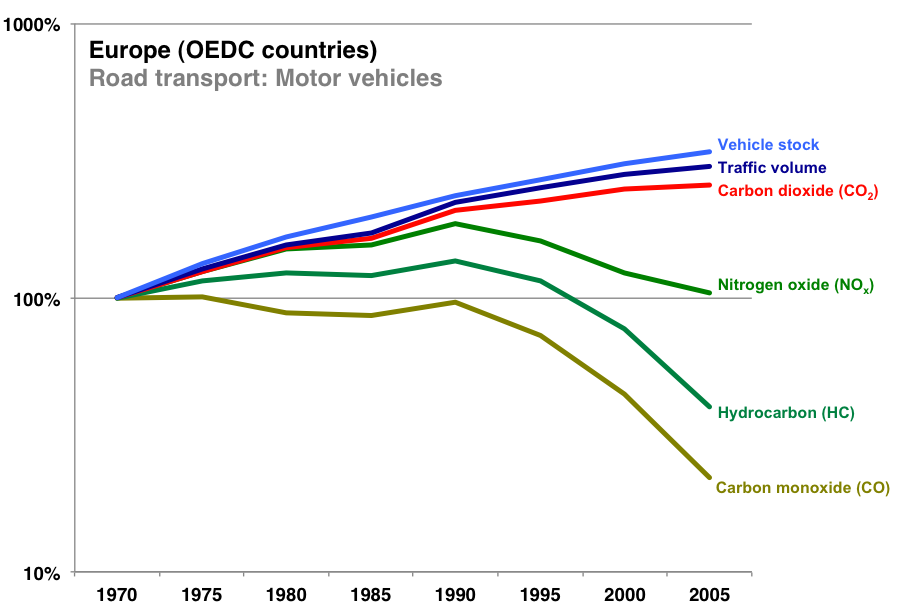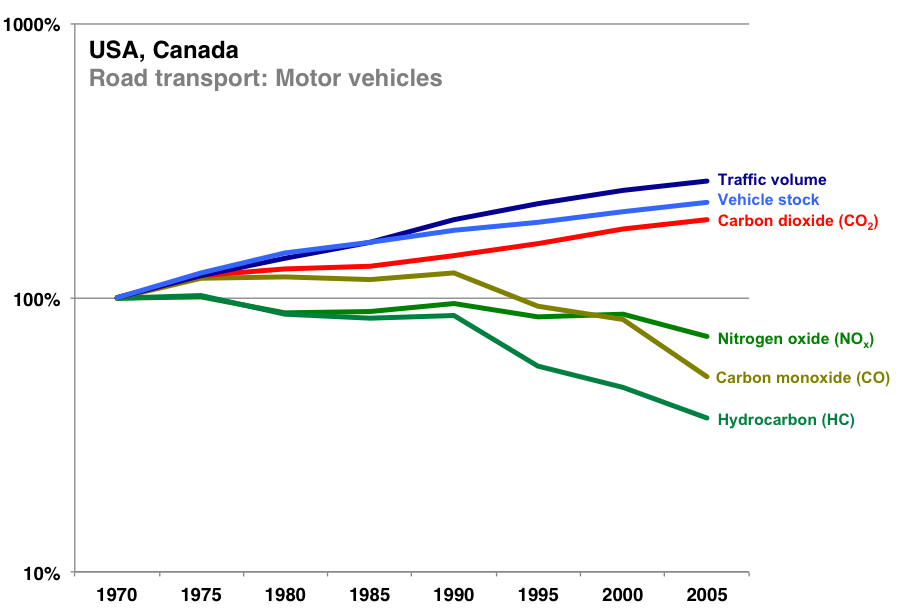Blog
Decoupling emissions from growing traffic volume
The total number of motor vehicles on the road in Western Europe more than tripled between 1970 and 2005, rising from about 80 million to 260 million. Over the same period, traffic volume as measured in vehicle kilometers traveled per year also tripled. Combining these OECD statistics with recent data from the Emission Database for Global Atmospheric Research (EDGAR) project shows some interesting changes in the correlation between traffic volume and the level of emissions in the road transport sector, as well as an important continuity.
 As figure 1 illustrates, nitrogen oxide (NOx) emissions followed the trend of increasing traffic volume until the mid-1980s. NOx emissions from motor vehicles were first regulated in the EU in 1977, and it was not until the introduction of the Euro 1 norm in 1992 that the permitted NOx emissions level was lowered significantly. Beginning in 1990, a clear downward trend in NOx emissions can be seen in the figure, which corresponds with tightening standards from 1992 to 2005 (Euro 1 to Euro 4). (It should be noted that this downward trend is not true for all components of NOx. See this report [PDF], prepared for Defra, on trends in NOx emissions in the UK.)
As figure 1 illustrates, nitrogen oxide (NOx) emissions followed the trend of increasing traffic volume until the mid-1980s. NOx emissions from motor vehicles were first regulated in the EU in 1977, and it was not until the introduction of the Euro 1 norm in 1992 that the permitted NOx emissions level was lowered significantly. Beginning in 1990, a clear downward trend in NOx emissions can be seen in the figure, which corresponds with tightening standards from 1992 to 2005 (Euro 1 to Euro 4). (It should be noted that this downward trend is not true for all components of NOx. See this report [PDF], prepared for Defra, on trends in NOx emissions in the UK.)
Decoupling hydrocarbon (HC) and carbon monoxide (CO) emissions from traffic volume happened earlier than it did for NOx. In Europe, passenger car emissions of both these pollutants were regulated beginning in 1970, and permitted levels were reduced over time. An additional important step was taken in 1988, when heavy-duty vehicles and buses were regulated for the first time at the European level.
The greenhouse gas carbon dioxide (CO2) is a different story. The level of CO2 from road transport in Europe has steadily increased since 1970, closely following the trend in traffic volume. CO2 is directly linked to fuel consumption, and while there have been voluntary agreements with manufacturers over the years to reduce the fuel consumption of passenger cars, binding CO2 emissions targets were not adopted until 2007. Similar targets have never yet been set for heavy-duty vehicles. Progress in reducing CO2 emissions on a per vehicle basis has so far been negated by the increasing number of vehicles and kilometers traveled. For the future there is hope that, with adequate emission standards in place, it will be possible to decouple CO2 emissions from traffic volume, as has been the case for NOx, HC and CO.
 Figure 2 draws a similar picture for the United States and Canada. As in Europe, the number of vehicles on the road has increased since 1970, from about 120 million vehicles to about 280 million in 2005, and traffic volume has also increased accordingly.
Figure 2 draws a similar picture for the United States and Canada. As in Europe, the number of vehicles on the road has increased since 1970, from about 120 million vehicles to about 280 million in 2005, and traffic volume has also increased accordingly.
The downward trend for pollutant emissions, particularly NOx, started earlier in North America than in Europe. This might be due to the fact that in some areas of North America, most importantly California, regulation of vehicle pollutant emissions started as early as the 1960s. A drastic reduction in emissions levels occurred in the early 1990s, when the Clean Air Act Amendments were adopted and the Tier 1 standards were introduced.
But, as is the case in Europe, CO2 emissions are a different story in the US and Canada. In the US, light-duty vehicle fuel consumption has been regulated since 1975, but the standards remained mostly unchanged between 1985 and 2010. This might be the reason why the level of CO2 in figure 2 starts increasing again from 1985 on. New corporate average fuel economy (CAFE) and GHG emissions standards for 2012–16 recently adopted by the US for light-duty vehicles, and heavy-duty vehicle standards in place for 2012-2016, promise to change the slope of the CO2 trend line, however, and proposed LDV standards for 2017–25 would have an even greater effect.
